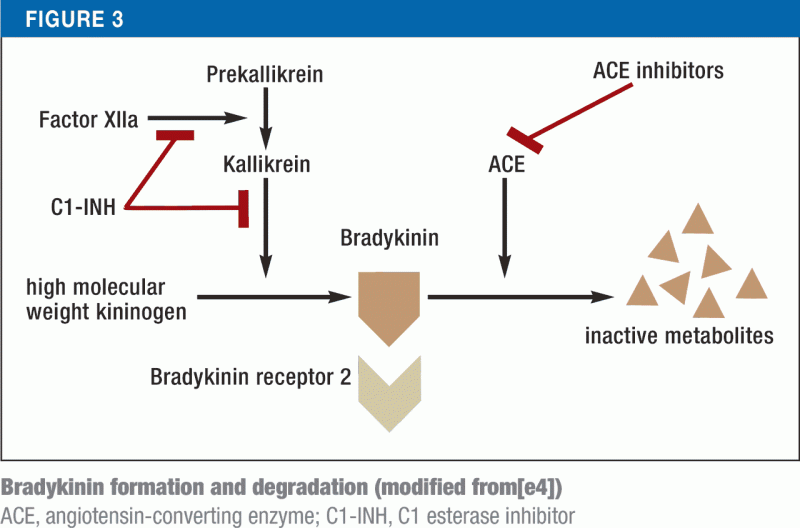The direct cause of angioedema is a loss of vascular integrity, which causes localized fluid shift from the blood into swelling in the tissue, hence “angio à edema.” Unlike your typical edema, angioedema tends to be non-pitting and is not gravity dependent.
In general, angioedema can be classified to 3 categories:
Histamine-mediated
Treat w/ antihistamines, steroids, epinephrine
Bradykinin-mediated
Can treat w/ fresh frozen plasma, C1 inhibitor concentrate, or some fancy bradykinin pathway inhibitors.
Will not respond to epinephrine, steroids, or antihistamines.
Other/unknown causes
For your critical patients, assume it is histamine mediated and treat with epinephrine empirically because the histamine pathway is more common, and the swelling tends to worsen very rapidly.
Histamine-mediated
Pathophysiology
Most commonly caused by allergen exposure causing IgE activation
Initial exposure to allergen à sensitization and plasma cell formation à repeat exposure à IgE mediated mast cell activation and histamine release
Some medications cause generalized mast cell activation
Opioids and radiocontrast dyes can do this
Will have severe reaction, even on initial exposure
COX inhibition
Caused by NSAIDs
Drives precursor molecules towards formation of leukotrienes à mast cell activation and histamine release
Bradykinin-mediated
Pathophysiology: Disruptions to kinin pathway cause increased concentration of bradykinin, leading to angioedema1. This is caused by 2 mechanisms:
Too much production of bradykinin
Hereditary/acquired angioedema causes too little functional C1 esterase inhibitor (C1-INH), which normally regulates bradykinin formation. This essentially releases the breaks and allows uncontrolled bradykinin formation.
TPA leads to increased bradykinin precursor as well.
Too little breakdown of bradykinin
ACE inhibitors prevent ACE from breaking down bradykinin
How do I tell what type of angioedema my patient has?
Testing for C1-INH is not useful in ED due to long turnaround times.
Histamine-mediated
Tends to be more acute and shorter lasting.
Usually caused by exposure to allergen
Bradykinin-mediated
Is not usually itchy
More commonly affects gastrointestinal mucosa, causing GI symptoms
Can be caused by stressor to body – i.e. surgical/dental procedure, infection, emotional stress.
ACE-inhibitor mediated. 43% occur within first month of treatment, although can happen years into the course.
TPA-mediated usually occurs in conjunction w/ ACE-inhibitor use.
Treatment
Follow normal ABC pathway
Airways can rapidly deteriorate. If intubating, you should have dual setup for surgical airway. Consider awake fiber-optic intubation in airway allows.
Fluids and pressors as needed for shock
In critically ill patients, follow the histamine-mediated pathway first because this pathway will have patients deteriorate more rapidly.
Histamine-mediated angioedema
0.3-0.5mg IM epinephrine (1mg/ml)
0.01mg/kg for pediatrics
Repeat q5-15min PRN up to 3 doses
Consider epi drip if refractory
In patients on beta-blocker, consider glucagon 1-5mg IV push, then 1-5mg/h infusion, to bypass beta-blockade.
Antihistamines
Benadryl, Pepcid
Steroids
Thought to reduce biphasic reactions, though recent studies are starting to question this2.
Bradykinin-mediated
Fancy drugs
Replacement options for C1-INH. These are plasma derived human concentrates.
Berinert – FDA approved for acute intervention
Cinrynze – FDA approved for prophylaxis only
Kallikrein inhibitors to cause decreased bradykinin production
Ecallantide
Block bradykinin receptors
Icatibant
Fresh frozen plasma, 2 units.
Will have physiologic levels of C1-INH, replacement ACE (a.k.a kininase II). Physiologic concentrations are much lower concentrations than the fancy drugs above, so requires larger volumes3.
Paradoxically, will also have physiologic levels of bradykinin and may have autoantibodies to C1-INH that can make angioedema acutely worse4. Case studies suggest this is rare, but be ready to intubate!
References
1. EM:RAP CorePendium. EM:RAP CorePendium. Accessed December 22, 2023. https://www.emrap.org/corependium/chapter/recgmcfxPSDNkQRTU/Angioedema
2. Lewis J, Foëx BA. BET 2: in children, do steroids prevent biphasic anaphylactic reactions? Emerg Med J EMJ. 2014;31(6):510-512. doi:10.1136/emermed-2014-203854.2
3. Chaaya G, Afridi F, Faiz A, Ashraf A, Ali M, Castiglioni A. When Nothing Else Works: Fresh Frozen Plasma in the Treatment of Progressive, Refractory Angiotensin-Converting Enzyme Inhibitor–Induced Angioedema. Cureus. 9(1):e972. doi:10.7759/cureus.972
4. Long BJ, Koyfman A, Gottlieb M. Evaluation and Management of Angioedema in the Emergency Department. West J Emerg Med. 2019;20(4):587-600. doi:10.5811/westjem.2019.5.42650








